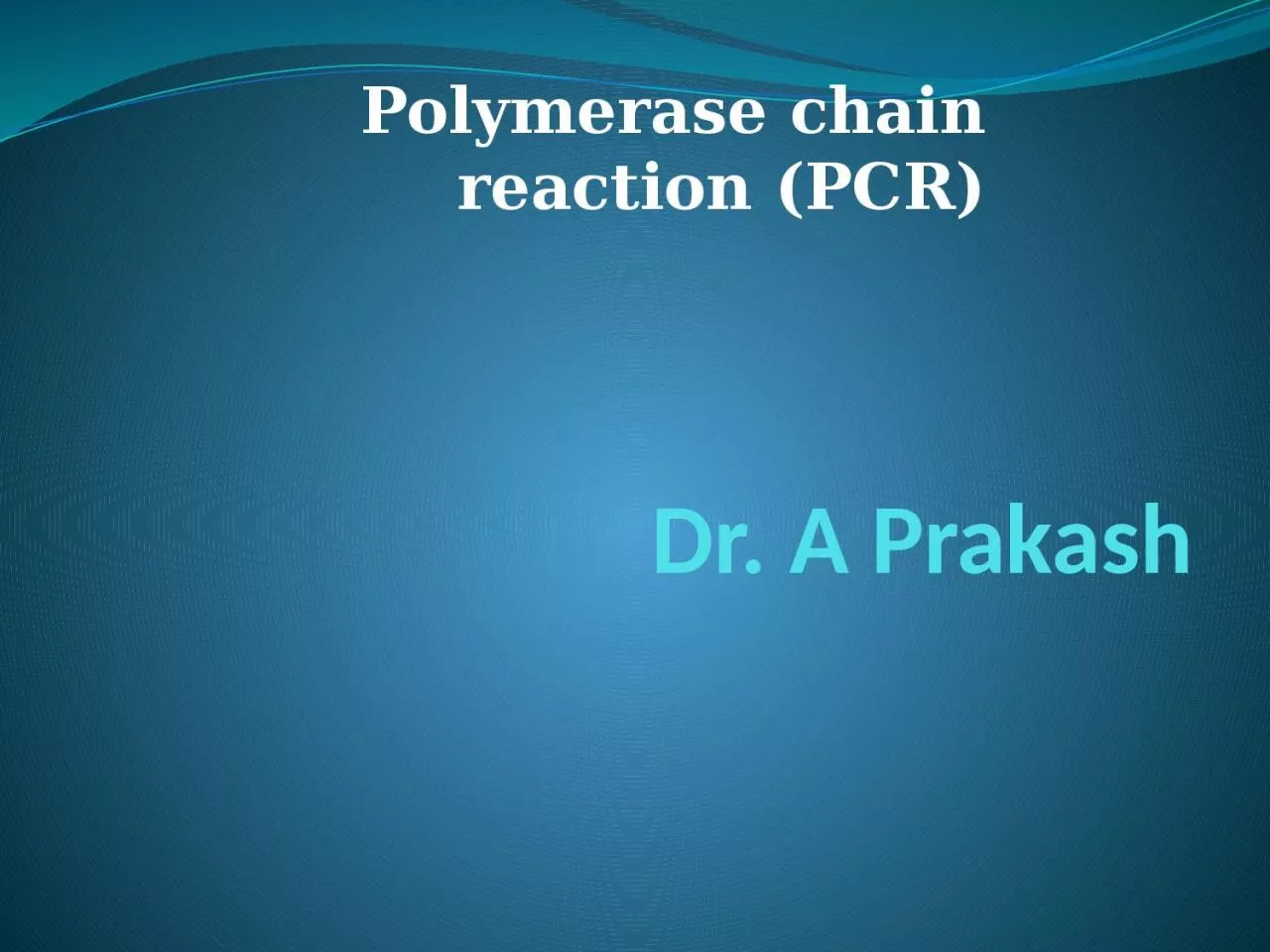

Key points Polymerase chain reaction or PCR is a technique to make many copies of a specific DNA region in vitro in a test tube rather than an organism PCR relies on a thermostable ID: 1044475
Download Presentation The PPT/PDF document "Dr. A Prakash Polymerase chain reaction..." is the property of its rightful owner. Permission is granted to download and print the materials on this web site for personal, non-commercial use only, and to display it on your personal computer provided you do not modify the materials and that you retain all copyright notices contained in the materials. By downloading content from our website, you accept the terms of this agreement.
1. Dr. A PrakashPolymerase chain reaction (PCR)
2. Key points:Polymerase chain reaction, or PCR, is a technique to make many copies of a specific DNA region in vitro (in a test tube rather than an organism).PCR relies on a thermostable DNA polymerase, Taq polymerase, and requires DNA primers designed specifically for the DNA region of interest.In PCR, the reaction is repeatedly cycled through a series of temperature changes, which allow many copies of the target region to be produced.PCR has many research and practical applications. It is routinely used in DNA cloning, medical diagnostics, and forensic analysis of DNA
3. PCRPolymerase chain reaction (PCR) is a common laboratory technique used to make many copies (millions or billions!) of a particular region of DNA. This DNA region can be anything the experimenter is interested in. For example, it might be a gene whose function a researcher wants to understand, or a genetic marker used by forensic scientists to match crime scene DNA with suspects.Typically, the goal of PCR is to make enough of the target DNA region that it can be analyzed or used in some other way. For instance, DNA amplified by PCR may be sent for sequencing, visualized by gel electrophoresis, or cloned into a plasmid for further experiments.PCR is used in many areas of biology and medicine, including molecular biology research, medical diagnostics, and even some branches of ecology
4. Taq polymerasePCR requires a DNA polymerase enzyme that makes new strands of DNA, using existing strands as templates. The DNA polymerase typically used in PCR is called Taq polymerase, after the heat-tolerant bacterium from which it was isolated (Thermus aquaticus)PCR primers Primer, a short sequence of nucleotides that provides a starting point for DNA synthesisPCR primers are short pieces of single-stranded DNA, usually around 20 nucleotides in length. Two primers are used in each PCR reaction, and they are designed so that they flank the target region (region that should be copied). That is, they are given sequences that will make them bind to opposite strands of the template DNA, just at the edges of the region to be copied. The primers bind to the template by complementary base pairing..
5. When the primers are bound to the template, they can be extended by the polymerase, and the region that lies between them will get copied.
6.
7. Steps of PCR:The basic steps are:Denaturation (96 °): Heat the reaction strongly to separate, or denature, the DNA strands. This provides single-stranded template for the next step.Annealing (55 - 65°): Cool the reaction so the primers can bind to their complementary sequences on the single-stranded template DNA.Extension (72 °): Raise the reaction temperatures so Taq polymerase extends the primers, synthesizing new strands of DNA.
8.
9. Using gel electrophoresis to visualize the results of PCRThe results of a PCR reaction are usually visualized (made visible) using gel electrophoresis. Gel electrophoresis is a technique in which fragments of DNA are pulled through a gel matrix by an electric current, and it separates DNA fragments according to size. A standard, or DNA ladder, is typically included so that the size of the fragments in the PCR sample can be determined.DNA fragments of the same length form a "band" on the gel, which can be seen by eye if the gel is stained with a DNA-binding dye. For example, a PCR reaction producing a 400base pair (bp) fragment would look like this on a gel:
10. A DNA band contains many, many copies of the target DNA region, not just one or a few copies. Because DNA is microscopic, lots of copies of it must be present before we can see it by eye. This is a big part of why PCR is an important tool: it produces enough copies of a DNA sequence that we can see or manipulate that region of DNA.
11. Applications of PCRPCR is used in many research labs, and it also has practical applications in forensics, genetic testing, and diagnostics.PCR in ForensicsSuppose that you are working in a forensics lab. You have just received a DNA sample from a hair left at a crime scene, along with DNA samples from three possible suspects. Your job is to examine a particular genetic marker and see whether any of the three suspects matches the hair DNA for this marker.The marker comes in two alleles, or versions. One contains a single repeat (brown region below), while the other contains two copies of the repeat. In a PCR reaction with primers that flank the repeat region, the first allele produces a 200bp DNA fragment, while the second produces a 300bp DNA fragment:
12. You perform PCR on the four DNA samples and visualize the results by gel electrophoresis, as shown below:
13. THANK YOU